Facing to the global scientific and technological frontiers, major national demands, and the national economy development, this authorized degree-conferring unit has achieved a number of scientific research achievements with major influence: 3 research projects in “Program 973”, 5 key researches and development programs, 6 major projects, and 5 key research projects supported by the National Natural Science Foundation of China, 2 research projects supported by the national key foundations for exploring scientific instrument, 2 integration project of major research plan of the National Natural Science Foundation of China. This degree authorized unit has achieved a number of scientific research achievements advancing in the disciplinary development, including 4 national science and technology awards, 11 awards at provincial and ministerial level, and more than 200 national invention patents for engineering application. For example, the holographic spectrum and fault diagnosis technology has become a “useful tool” to ensure the safe operation of major equipment; the 3D printing technology has been used in biomedical field, which has been employed for the world-first customized structural reconstruction on the mandible defect.
(1) Project in “Program 973”:The Basic Research on High-speed Machining and Equipment
Presided by: Prof. Lu Bingheng
Contract funding: 35.56 million RMB
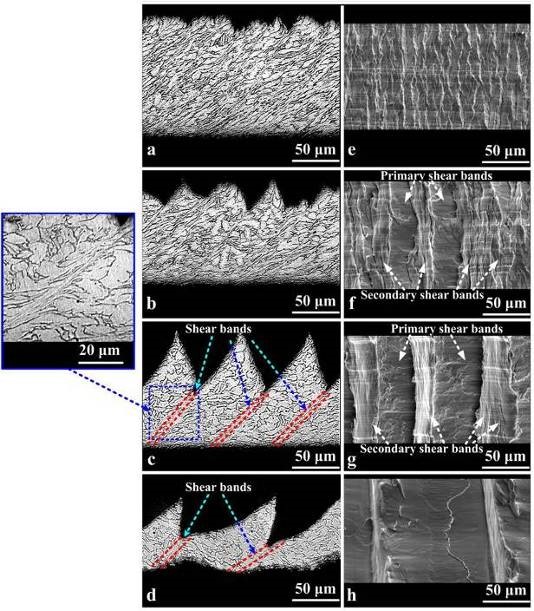
Fig. 3-1 Chip shape and free surface microstructure of titanium alloy
Major Progress and Results:Focusing on the core technology of ultra-high-speed cutting tools and equipment, the research team explored material sudden deformation and removal mechanism under the action of ultra-high-speed machining and multiple fields, revealing the scientific nature of ultra-high-speed cutting (shown in Figs. 3-1 and 3-2). The interface interaction of the tools and workpieces, mechanical joints, bearings and lubricating medium under strong thermo-mechanical coupling is also studied. Thus, the access to high-speed machine tool integration technology and independent design capability is acquired by the team. The innovative results include: 1) the construction of a number of research platforms for high-speed cutting experiments and high-speed machine tool equipment technology (The cutting speed of the cutting experiment platform and the physical simulation test bench is respectively up to 10000 m/min and 12000 m/min); chip root acquisition in ultra-high-speed cutting, and new technologies and devices of wireless thermocouple testing for cutting temperature and high-frequency cutting force testing; ultra-high-speed grinding experimental platform (surface grinder with grinding speed up to 10200 m/min; cylindrical grinder with grinding speed up to 11400 m/min); evaluation platform for preparation and heat transfer performance of heat pipe grinding wheel. 2) findings of the mechanism of ultra-high-speed cutting/grinding: obtaining the interpretation and criteria on the mechanism of ultra-high-speed cutting of aluminum alloys and several difficult-to-machine materials, revealing the brittle-ductile transition mechanism in high-speed grinding of brittle materials, and finding an ultra-high-speed grinding method for significantly improving the surface integrity and processing efficiency of brittle materials.
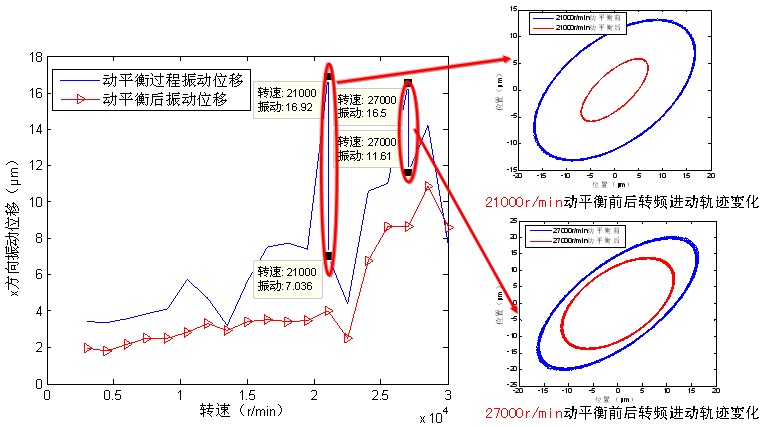
Fig. 3-2 On-line dynamic balance analysis of high-speed spindle: the blue lines refer to deflection before dynamic balance,
the red lines with triangles refer to the deflection after dynamic balance.
These projects in total won the second prize of the National Natural Science Award, the second prize of the National Science and Technology Progress Award, and the second prize of the National Technology Invention Award. The research team has published 563 academic papers (169 of them are included in the SCI), 3 monographs, and has applied for 146 invention patents (70 are awarded). The research team consists of 3 Innovative Research Teams in University of the Ministry of Education of China, with 1 recipient of the National Science Fund for Distinguished Young Scholars, 4 Chang Jiang Scholars, 1 scholar of National Thousand Talents, and has cultivated 260 postdoctoral/doctoral/graduate students.
(2)Project in “Program 973”:Basic Research on High-performance Rolling Bearing
Presided by: Prof. Wang Yu
Contract funding: 26.54 million RMB
Major Progress and Results:Focusing on major common problems during the design, manufacturing and application of key components of high-speed railways, precision machine tools and other major equipment, the research team carried out research on dynamic lubricating contact theory in multi-interface system of high-speed heavy-duty precision bearings, structure-control and performance-control manufacturing of components in high-speed heavy-duty precision bearings and service performance of bearing under complex conditions. Main progresses and results include: 1) preparation and application of lubricating materials based on bearing multiple lubrication film mechanism: a grease called TG-30 for high-speed rail has been developed; the service life of grease in extreme working conditions such as high speed, high temperature and heavy load by using FE-9 bearing life testing machine has been studied, the results showing that the service life of TG-30 grease is equal to that of the target sample Shell 2858; for the problem that the heat generated by bearing ribs is much higher than that by the bearing raceway, the research team carried out study on the composite solid lubricating film in realizing the preparation of multi-element doped nanocomposite self-lubricating films. 2) research on service performance control of high-speed heavy-duty precision machine tools: focusing on the service performance of high-speed heavy-duty precision bearings, the research team carried out study on modeling of bearing main engine system, bearing precision creation, service performance creation, and control basis under complex conditions and service conditions, and developed the online test system of bearings preload and online control system of bearings preload, as shown in Figs. 3-3 and 3-4.
The research team has published 239 academic papers (142 are included in SCI) and 3 academic monographs and has applied for 47 national invention patents. It also won one second prize of the National Science and Technology Progress Award.
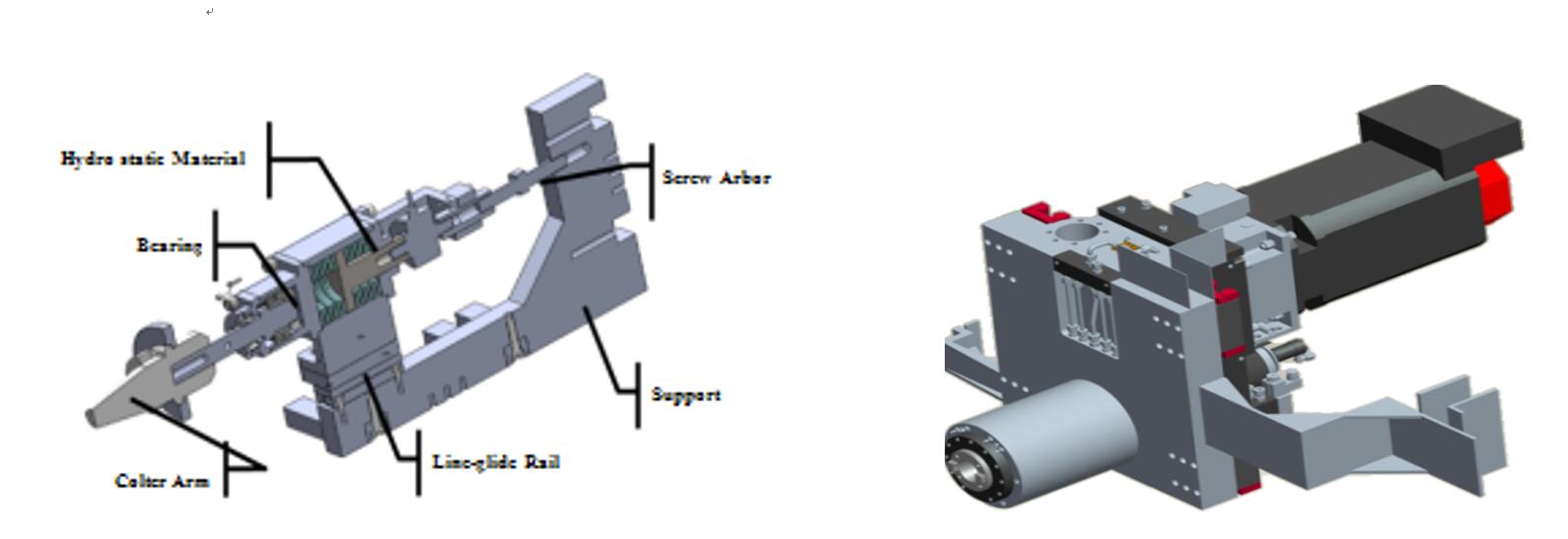
Fig. 3-3 Monitoring device for spindle preload Fig. 3-4 Hydraulic adjustment device for spindle preload
(3)Project in “Program 973”:Basic Research on Aero-engines Operation Safety
Presided by: Prof. Chen Xuefeng
Contract funding: 35 million RMB

Fig. 3-5 Three types of spectrum diagnosis technology
Major Progress and Results:Focusing on major national demands for the operational safety of aero-engines under extreme service conditions, such as high speed, high temperature, heavy load, and strong disturbances, the research team conducted systematic study on the operational safety of aero-engines at the three levels of damage mechanism, status awareness, and accident prevention based on three key components such as hot runner, cold-end blades and dual-rotor that determine the operational safety of aero-engines, in view of the multiple, incidental, and catastrophic failures of aero-engines.
The representative innovations are as follows: 1)In the aspects of vibration transmission and fault tracing of aero-engines, the study of vibration failure mechanism targeted to the key components of aero-engine such asdual-rotorand bearing, based on the theory of nonlinear dynamics. Focusing on the variable stiffness vibration of rolling bearing, the dynamic characteristics of the rolling bearing-rotor system were studied for revealing the contact resonance mechanism of the rolling bearing-rotor system. The theoretical method for the periodic solution of the complex nonlinear system was developed, coming into the technical paths for the nonlinear dynamic characteristics of thedual-rotorsystem and vibration failure mechanism.2)In terms of the principle of engine sparse diagnosis and health maintenance research, the research team, starting from the sparse theory, carried out the status monitoring and health maintenance methods for key engine parts such as intermediate bearings and roulette wheels. Considering the disadvantage of weak signal under few measuring points and strong noise, the mechanism of signal feature perception under sparse framework was studied, proposing the feature information reconstruction algorithm based on convex optimization theory for solving the status monitoring problems by weak feature extraction for the key components (as shown in Fig. 3-5). The law of vibration signal changes by taking bearing as the target was studied, and the status monitoring method was proposed for providing technical supports for the safety assessment and decision-making mechanism of the whole engine.
(4)National Key R&D Program: Laser Fine Manufacturing Process and Equipment for Aerospace Complex Components Surfaces
Presided by: Prof. Mei Xuesong
Contract funding: 46.45 million RMB
Major Progress and Results:On the basis of surface fine manufacturing techniques for key components, such as spacecraft antenna fixed surface reflectors, radar component frequency selectors, quartz hemispherical resonator gyro electrostatic excitation shields, aerospace ceramic cores, and casings, the mechanism of laser parameters and beam scanning acted upon typical materials was explored, the methods for the control strategy of the beam scanning characteristics was studied, and the transformation law of the photo-induced characteristics in typical materials and the mechanism with laser was discovered. The representative innovative achievements of the project include:1) Focusing on the spacecraft antenna fixed surface reflector, surface pattern manufacturing of frequency selector, the optimal processing method for the line spot fixed-point etching was determined. Focusing on the ultrafast laser marking in aero-engine turbine components, the femtosecond laser hole marking was applied. Focusing on the aero-engine blade alumina ceramic core ultra-fast laser repair, the use of high frequency picosecond ultrafast laser was determined for obtaining burr flash laser repair parameters. Focusing on the aero-engine turbine outer ring material femtosecond laser processing, the experimental process, namely, carrying out micro-groove processing after ultra-fast laser polishing, was determined. Focusing on the aero-engine machined annular thin-walled cylinder laser engraved equipment, and the basic process research by CO2pulsed laser and 1060 nm fiber laser was carried out, obtaining a series of parameters that meet the laser engraving process requirements. 2) The manufacturing of picosecond laser fine manufacturing equipment with typical component pattern and aero-engine machined annular thin-walled cylinder laser engraved equipment were completed. The femtosecond laser-based surface integrity marking equipment, picosecond laser-based repair equipment for aero-engine blade ceramic core, and the overall structure design of femtosecond laser-based repair equipment for aero-engine turbine components were completed as shown in Fig. 3-6.
Fig.
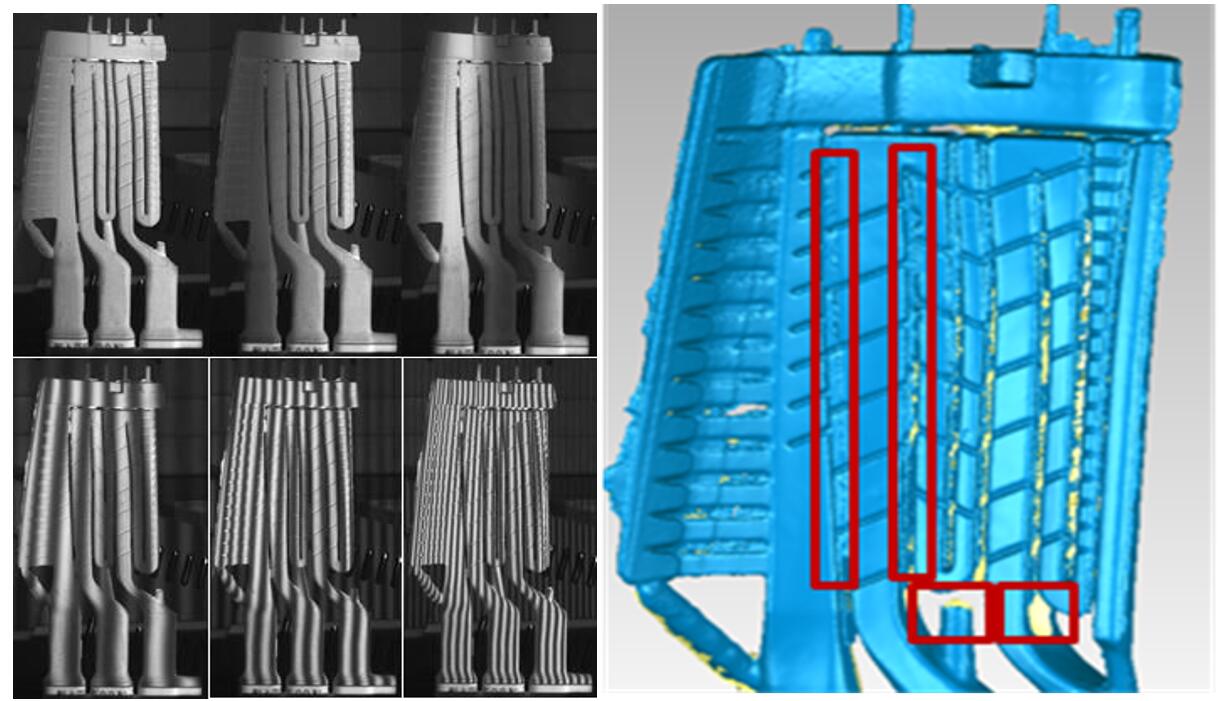
3-6 3D detection and reconstruction test for Ceramic Core
(5)Major Project for National Science and Technology Research: High-speed and High-efficiency Processing Technology and Equipment Technology Innovation Platform
Presided by: Prof. Chen Yaolong
Contract funding: 46.24 million RMB
Fig.

3-7 Ultra-dense tooth diamond cutter face and Nine-axis five linkage machining center
Major Progress and Results:Focusing on the common scientific issues in high-efficiency processing technology, testing and analysis of machine tool functional components, high-speed machine tool design, and machine tool performance testing and evaluation, research related to ultra-high-speed machining process and tool, thin-walled parts processing, dynamic design of ultra-precision functional components, common technology of overall design, overall machine dynamic error and failure were conducted by adopting the theory and experimental verification methods related to the above common problems. Innovative research achievements include: the development of an all-in-one full ceramic spiral end mill and high-speed face milling cutters with the milling of aluminum alloy wire speeds of 5000 m/min; the development of ultra-dense milling cutters for aluminum alloy and titanium alloy processing in aerospace and automotive applications; the research of high-speed bearing Nano greases and key technology; the development of ultra-precision oil hydrostatic guides, turntables and spindles, and their successful application in ultra-precision milling and grinding machine; the development of Nine-axis five linkage double-cutter blade machine, which partially solved blade machining in the aerospace industry and a lower degree of processing efficiency. The project has come into 23 new products and new technologies, published 31 academic papers, applied for 2 international invention patents and 29 Chinese invention patents, formed 10 norms and standards, won one first prize for the Scientific and Technological Progress Award of the Chinese Ministry of Education, and 1 Second Prize of the National Natural Science Award, and two provincial and ministerial awards. The research results have been applied in the fields of aerospace, main machine tool, functional components, military and automotive industries as shown in Fig. 3-7.
(6)Project Supported by the National Natural Science Fund: Multidimensional Spectrum Feature Modeling and Integrated Design Method for Complex Electromechanical Systems
Presided by: Prof. Zhao Wanhua
Contract funding: 2.8 million RMB
Major Progress and Results:Based on the complex electromechanical system of high-end CNC (Computerized Numerical Control) machine tools, and the dynamic characteristics evolution law of the machine, electricity, and control systems and the complex coupling relationship between them, a multidimensional spectrum feature modeling method was proposed for analyzing the multi-dimensional evolution law of the dynamic characteristics of the system and the output characteristics of the servo drive which varies with position, velocity, acceleration, and load. Aiming at the multi-axis linkage machining process, a dynamic integrated modeling method for feed motion and milling process of CNC-servo-mechanical system was proposed. The project has achieved three representative innovations: 1) A multidimensional spectrum feature modeling method for complex electromechanical system (multi-axis CNC machine tools) was proposed, and an analytical model varying with position and parameters in the dynamic characteristics of each axis of motion and motor torque (force) output characteristics was established, and the multidimensional spectrum evolution law of motion accuracy was quantified. 2) The electromechanical coupling problem in complex electromechanical systems was studied, which reveals the nature of electromechanical coupling, and proposed a solution to the reduced accuracy of motion caused by coupling.An integrated modeling method for the movement control of CNC machine tool feed axes and milling process was proposed, which revealed the influence law of the cutting process on the linkage precision of the machine tool. And the physical simulation of the part processing process that can accurately predict and trace the machining error was realized as shown in Fig. 3-8.
Based on this project, 54 academic papers have been published (29 of them in SCI, 11 of them published in IJMTM, MSSP, and JSV), 30 graduate students were trained, 13 national invention patents were applied (2 are awarded), 12 software copyrights were registered. In the machine tool host company, large-scale enterprises on aerospace and machine tool user companies, the research achievements have been promoted and applied.
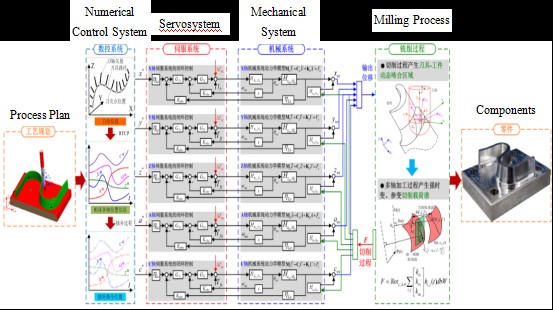
Fig.3-8 Machine feed system and milling process dynamics integration model
(7)Project Supported by the National Natural Science Fund: Fundamental Study on Multi-directional Vibratory Incremental Roll Plastic Forming of Complex Parts
Presided by: Prof. Zhao Shengdun
Contract funding: 3 million RMB
Major Progress and Results:Focusing on the integration tasks of spline shaft and other complicated parts with high-efficiency, high-performance and high-accuracy forming and realization demand, a new process principle for multi-directional vibratory incremental roll plastic forming of complex parts under the coupling effect of vibration field, temperature field, and local loading force field generated by rolling molds was proposed. Several AC servo motors were used as driving elements in exerting a specified frequency vibration field and a local loading force field along the axial, tangential and radial directions of the work piece, and an electromagnetic induction heating oil was used for obtaining the complex part temperature field of which temperature changes as gradient along the radial direction. In the changing temperature field, the horizontally placed work pieces were rolled and formed under the action of an incremental local load force field of not less than 3 rolling molds uniformly distributed along radial direction. The main progresses achieved in the project include: 1) The prototyping machine of an AC servo driven axially propelled multi-directional vibratory incremental roll forming was developed, including a rolling spindle with a direct drive rotary switching flux permanent magnet motor and a linear feed permanent magnet linear. And the dynamic characteristics of the two drive motors were obtained. 2) The axial propulsion forming experimental study of the spline shaft was carried out, and the spline shaft formed by rolling under different materials, temperatures, billet diameters, and mold speeds was obtained, and the influence law of main process parameters which acted upon the rolling forming was obtained. 3) The experimental study on the rolling spindle with a direct drive motor and its servo control was carried out, and the empty load characteristic of the drive motor was obtained (as shown in Fig. 3-9).

Fig.3-9 Assembly of spindle drive prototype
Based on the project, 32 academic papers have been published (18 articles in SCI), 16 national invention patents were awarded, and 3 postdoctoral and 14 graduate students were trained.
(8) Projects in “Program 863”: Multi-Material and Multi-Light-Source Large Laser Sintering Molding Equipment and Its Application
Presided by: Prof. Tian Xiaoyong
Contract funding: 12.62 million RMB
Fig. 3-10 heat affected zone of multi-materials and prediction of process parameters
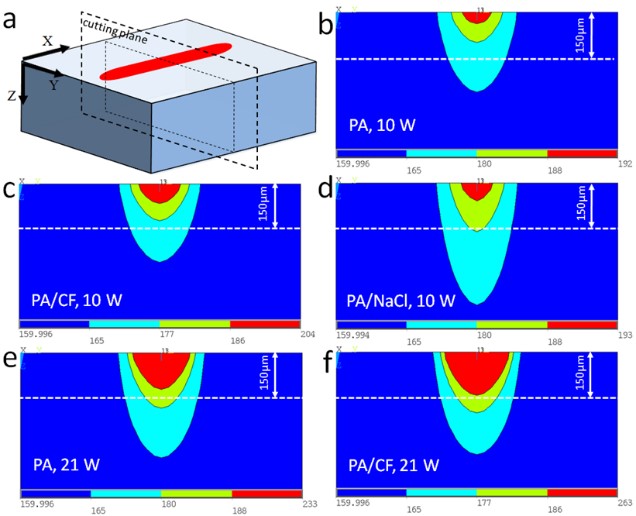
Main Progress and Results:Focusing on the rapid manufacturing requirements for large-scale complex parts and their molds, modular design, multi-light source coordination, and multi-material modification research methods were adopted for developing multi-material and multi-light source large-scale laser sintering molding equipment and its application. Subzone preheating, dynamic adjustment of process parameters and other methods were proposed. It was found that sub-area preheating can better maintain the uniformity of the powder bed temperature, and problems like warpage caused by uneven temperature in the process of multi-material selection laser sintering can be prevented through the dynamic adjustment of process parameters. The representative innovations achieved include: 1) Sintering mechanism: The sintering mechanism of multi-materials was studied by establishing the model of the body light source. The results showed that the introduction of the additive phase changed the physical properties of the powder material, leading to obvious change in heating, heat transfer and melting processes in the sintering process in the selected area. The result provides theoretical guidance for the setting of laser sintering process parameters in multi-material selective zones. 2) Large-scale equipment: Four lasers and four galvanometers synchronous scanning technology were used, with the size of the tabletop of 2 meters by 2 meters, so the macro and micro-structures of large-scale parts can be integrally formed. The mechanical design, assembly and commissioning of large-sized multi-material selection laser sintering forming equipment have been realized, by which the mosaic error of the full-field multi-scanner in a four-light system was reduced, as shown in Fig. 3-10.
(9) Projects in the “863 Program”: Research and Development of Intelligent Robot Bionics Technology
Presided by: Prof. Guanghua Xu
Contract Funding: 39.45 million RMB
Main Progress and Achievements: This project is the only frontier research project in robot field in the “Program 863” during the 12th Five-Year Plan. It focuses on the key technology of robotic intelligent bionics for achieving the leap from human-shape robot to human-wisdom robot. It will be used for providing technical support for unmanned chariot, smart factory and rehabilitation services for aging society in the future. The project was led by Xi'an Jiaotong University and jointly studied with 8 units including Tsinghua University, Shandong University, National Rehabilitation Aids Research Center, and China North Industries Group Corporation.
The project topic of “Multiple Source Information Motion Fusion Perception of Brain Muscle and Interaction Control Technology and Rehabilitation Robot Application Verification” of Xi'an Jiaotong University covers the scientific issues related to human-computer interaction perception and collaborative control in the research and development of rehabilitation robots, using bio-information analysis of human beings and idea decoding for research on the motion intention and pose perception of multi-source information of brain muscles, human-computer interaction control, rehabilitation status assessment, and rehabilitation system integration technology.
The representative contributions include: 1) The research result of the fine motion decoding technology based on the normalized characteristics of myoelectricity enabled the effective identification of 10 kinds of lower extremity motion patterns such as hip adduction/abduction, knee flexion/extension, supra/flip, walk and jump. 2) The active and passive cooperative motion interactive control technology based on brain muscle information was proposed, and a new central nervous system rehabilitation training method was utilized for achieving a functional compensation control strategy for rehabilitation robots. 3) A comprehensive evaluation method for stroke rehabilitation status was proposed by integrating brain near-infrared, limb electromyographic and somatosensory movement characteristics, and a quantitative evaluation of human motion status was achieved. 4) By studying on the brain-based active and passive collaborative sensing and control technology, a brain-controlled lower limb active and passive coordinated rehabilitation training system was developed, and the “bridge” reconstruction of the motor nerve channel was realized. The patient’s clinical trials showed that the main rehabilitation evaluation indicators were improved by more than 20%, achieving good application results. The corresponding achievements are reported by CCTV (China Central Television) as shown in Fig. 3-11.
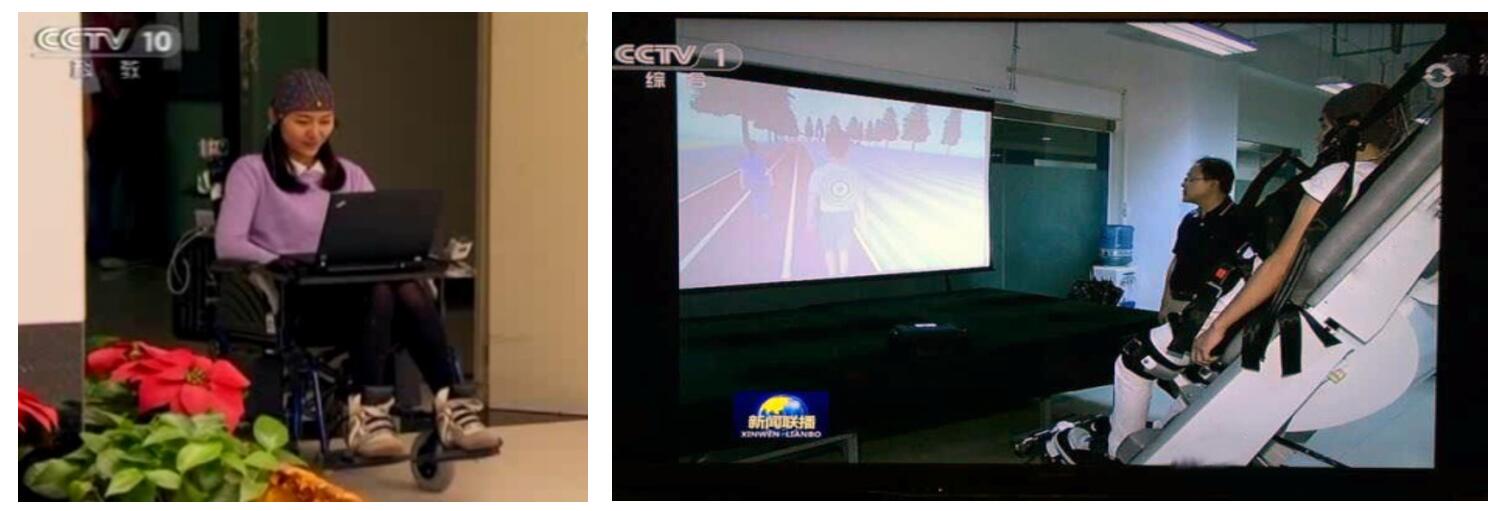
Fig. 3-11The CCTV (China Central Television) science and education channel introduces brain-controlled wheelchair; CCTV news broadcast report on brain controlled lower limb rehabilitation training system
(10) Projects in the “Program 863”: Micro Nano Sensor and System for Mechanical Process Monitoring Such as Cutting
Presided by: Prof. Yulong Zhao
Contract Funding: 7.84 million RMB
Main Progress and Achievements:Based on the engineering requirements for cutting quality control, tool life prediction, and intelligent machining process monitoring in the machining process, MEMS silicon micro force sensitivity chips combining with machine tools and work platforms were adopted for the development of micro-nano multi-sensors and wireless sensor network system with on-line real-time monitoring functions (vibration and cutting forces, temperature, etc.). Strategy of the sensor design based on composite multi-beam, orthogonal octagonal ring and parallel multi-beam structure and the cross-interference suppression methods were proposed. Based on the research, high-frequency MEMS (Micro-Electro-Mechanical System) Accelerometers, 3D cutting force sensors on turning, rotary two-component milling force sensors, fixed four-component milling force sensors, MEMS temperature sensors, and wireless network systems were developed, solving practical problems including machine tool cutting quality control, tool life prediction, and intelligent machining monitoring. This research result has reached to the leading level in technology advancement in China and has been applied to high-performance lathes and milling machines as shown in Fig. 3-12. It well satisfies the requirements for tool cutting quality control, tool life prediction, and intelligent machining process monitoring during machining, effectively realizing high automation control and high precision machining of the intelligent machine tool.

Fig.3-12 Integrated Cutting Force Sensor Design and Structure